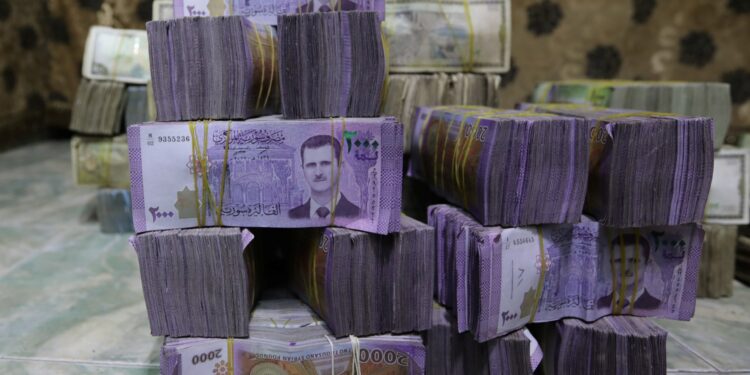Only two weeks had passed since the collapse of the regime of ousted President Bashar al-Assad, until the fate of the Syrian pound, which had lost more than 94% of its value against the US dollar during the years following the outbreak of the country’s crisis in 2011, came to the fore.
Today, the exchange rate of the dollar at the Central Bank of Syria is about 15 thousand pounds, according to a daily report issued by the Central Bank of Syria to guide individuals and companies in the country.
Foreign reserves
Unofficial estimates indicate that reserves have been exhausted, and in 2011, the Central Bank of Syria’s last statement to the International Monetary Fund about the size of available foreign exchange reserves was approximately 14 billion US dollars.
During the years that followed that year, Syria suffered from a scarcity of foreign exchange, amid the country’s need to provide basic goods and finance the regime’s forces, coinciding with US sanctions that restricted the regime’s access to foreign exchange.
The latest release of the world’s gold reserves, from the World Gold Council, indicates that the yellow metal’s reserves – in Syria – amounted to about 25.8 tons in June 2011, equivalent to its current value of approximately 2.23 billion US dollars, without knowing the fate of the reserve after that date. .
Chronological sequence
The Syrian pound witnessed radical shifts in its value against the US dollar from 2010 until December 2024, in light of the political and economic events that struck the country, which were directly reflected in the local economy and the exchange rate:
- In 2010, the Syrian economy was relatively stable, and the exchange rate of the lira against the dollar was trading at a level of 47 to 50 Syrian pounds per dollar.
This period witnessed stability in monetary policy, as the government relied on strengthening traditional economic sectors, such as oil, agriculture, and tourism, with relatively stable cash flows from crude sales.
- With the outbreak of popular protests in March 2011 and turned into a political crisis, the value of the Syrian pound began to gradually decline due to economic and political uncertainty.
- By 2012, the exchange rate had fallen to about 65-70 liras to the dollar, with increasing economic pressures and the start of Western sanctions on the Syrian regime.
During this period, the Syrian pound witnessed a sharp collapse as a result of the escalation of the military conflict, international sanctions, and the loss of control over several areas rich in resources.
- With oil production shrinking and exports almost stopping, the lira’s exchange rate fell to about 150-180 lira to the dollar by 2013.
- In 2014, as battles increased and ISIS took control of strategic areas, the exchange rate fell to about 200-220 liras to the dollar.
- Between 2015-2016, the economic crisis worsened sharply as it coincided with a decline in domestic production and the government’s loss of control over most oil fields in the northeast.
The high costs of war also led to a large financial deficit, while sanctions further isolated Syria from international markets.
- By the end of 2016, the exchange rate reached about 500 Syrian pounds to the dollar, a record low level at the time, which represented a major collapse in the purchasing power of Syrians.
- In 2017-2018, with Russia’s military intervention in the Syrian crisis, the regime was able to regain some strategic areas, giving indications of relative stability.
However, the Syrian pound remained under pressure due to continued sanctions and lack of resources. The exchange rate stabilized between 430 and 500 liras to the dollar during this period, but the economy was unable to recover as a result of the destruction of infrastructure and the decline in investments.
- 2019 was a difficult turning point for the Syrian pound, as the financial collapse in Lebanon exacerbated the liquidity crisis in Syria; Many Syrian merchants relied on the Lebanese banking sector to finance their activities.
With the collapse of US dollar-denominated cash in many Lebanese banks, foreign exchange flows to Syria decreased, and the exchange rate at the end of 2019 reached about 900-1,000 pounds to the dollar.
- In mid-2020, the US Caesar Act entered into force, imposing severe sanctions on the Syrian economy. This law caused an additional collapse of the currency, as the exchange rate exceeded the threshold of 3,000 liras to the dollar for the first time in history.
- The Syrian pound continued its decline during 2021 and 2022, with the absence of any radical economic solutions and high dependence on foreign aid. In 2021, the exchange rate reached the range of 3,500-4,000 liras to the dollar. As for 2022, economic pressures rose again with the increase in global energy prices following the Russian-Ukrainian war. The Syrian pound reached the level of 4,500-5,000 pounds to the dollar by the end of the year.
- In 2023, the Syrian pound reached its lowest levels ever due to worsening internal crises and declining external support. During the first half of the year. The exchange rate ranged between 6 Thousands and seven thousand liras to the dollar, but in the second half it witnessed a sharp collapse, reaching about 13 thousand liras to the dollar on the black market by the end of the year.
- At the beginning of this month, the exchange rate of the lira reached a new low, reaching 16,000 against the dollar, due to indications of increasing opposition control over large areas of the country.
- With the collapse of Bashar al-Assad’s regime, the lira began to regain some of its health, recording a level of 10,000 liras per dollar before falling to approximately 15,000 against the dollar, awaiting international reassurances that might push the Syrian currency against foreign exchange.



